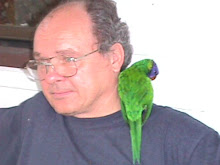
When we first ventured out into the South Burnett, in search of a more relaxing brand of birding [we’ve been around the world on a number of occasions, chasing “ticks”] we seriously thought we were the only birders in the region. Or at least, in all my days with Birds Queensland [including a stint as President] I’d only ever heard of one South Burnett birder and he had died in the early 1990s.
When we purchased the property, the real estate agent did mention that there were a couple of locals interested in birdwatching but she had few details and I came away with the distinct impression that she meant an couple of old dears who scattered a few breadcrumbs around their backyard. Not quite what we had in mind.
The first real inkling that we were not alone came when I found Birds Queensland’s new website; their “old” website had been no more than adjunct to my own personal website which of course expired once Fay and left in search of greener birding pastures. Among the several “rare bird sightings” we came across a claim of Australian Bustard [Ardeotis australis] in the Kingaroy area. Kingaroy, a few miles up the road, is a little beyond their accepted range. Not surprisingly, the claim has been forwarded to the Queensland Rarities Committee.

It still didn’t really filter through. The three birders involved were probably no more than passing itinerants who struck lucky [or had a collective vivid imagination]. The area continues to attract a substantial number of passing birders, especially those in search of Black-breasted Button-quail.
A short while later I noted the same three names claiming a Crested Shrike-tit in Din Din State Forest. There was no problem with the claim itself, Crested Shrike-tit has been noted here on a number of occasions but Din Din is not on the normal beat of itinerant birders in search of Black-breasted Button-quail. The penny began to squeeze through the dim mists.
Their names appeared again. Then yet again. A quick search through the local telephone directory revealed that people with all three surnames lived in the immediate area; Fengland lived no more than three kilometre away!
The answer was obvious, telephone. Yet I hesitated. I’d been warned to be wary of country xenophobia, the local yokels do not take kindly to Big Boys from the City trying to tell them what or how to do things. That was not my intention but I was an ex-President of the Society and I was from the City.
Fay and I added a few of our own Nanango sightings [with Glossy Black-Cockatoo as the ultimate carrot] hoping that one or all of these unknown birders would contact us. They didn’t.
The matter was finally resolved because of an aberrant Sacred Kingfisher. This is a summer visitor to the South Burnett but Fay and I had recorded a sighting in June [austral winter]. Being a inveterate hoarder by nature I tend to keep ALL my original records, sometimes down to the odd scrap of paper that was the only thing at hand on which to record a sighting. I double-checked these and sure enough we had Sacred Kingfisher as present in June 2003.
The only solution I could see was to telephone one of the “Bustard” birders to check if they had any similar aberrations in their records. As the Fenglands were the closest I plumbed for them and when a female voice answered I explained that I was hoping to speak to Robert, the birdwatcher. The voice became a little surprised if not quite indignant. She was the birdwatcher in their household, Robert merely tagged along to keep her company.
Chauvinistic moment of embarrassment, but all’s well that ends well.

Indeed, all three of the “Bustard” birders have turned out to be the female of the species. We arranged to bird East Nanango State Forest. Others joined us on our inaugural joint outing. From being alone we are suddenly part of a small group of dedicated South Burnett birders.
Fay and I were with two of the group when we flushed the Black Bittern at Brooklands.
The tale continues. We met two further, albeit beginning, local birders via a lutinistic Brown Honeyeater. That tale will have to wait awhile.
The Year List has risen to 134, however, rather than list the entire tally I simply include the additions since the last blog.
Yellow-tailed Black-Cockatoo
Southern Boobook,
Australian Brush-turkey
Golden-headed Cisticola
Rock Dove [introduced]
Bar-tailed Godwit
Tawny Grassbird
Spectacled Monarch
White-eared Monarch
Eastern Osprey
Pied Oystercatcher
Spotted Pardalote
Eastern Yellow Robin
Grey Shrike-thrush
Common Starling [introduced]
Crested Tern
Dusky Woodswallow
White-breasted Woodswllow
TOP 5
1. Black Bittern
2. Australian Hobby
3. Spectacled Monarch
4. Black-eared Cuckoo
5. Ground Cuckoo-shrike

No comments:
Post a Comment